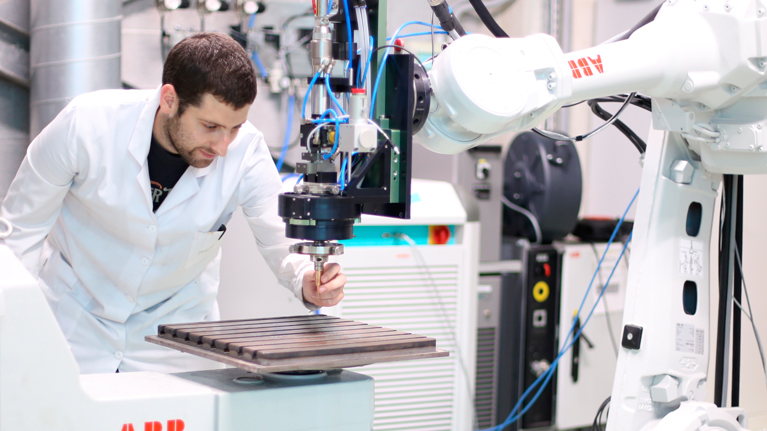Additive wire manufacturing, a solid bet for the aeronautical and energy industries
When wire material is deposited to manufacture metal parts, it becomes possible to improve process efficiency and resilience and use less raw materials.

The industrial sector is currently looking for new solutions to increase manufacturing process efficiency, upgrade the quality of the components to be manufactured and also reduce costs in terms of raw materials and energy consumption.
Nowadays, manufacturing processes used to produce metal components based on a 3D wire deposition technique represent a technology with a highly promising future in terms of manufacturing very large components for sectors like the aeronautical business. The energy sector, moreover, believes it as an efficient alternative for processes in which components are repaired, cladded or coated.
The Basque technology centre IK4-TEKNIKER is currently developing and marketing concentric heads for wire that can manufacture parts by means of a technique known as laser cladding or Laser Metal Deposition (LMD).
“Although this is a relatively new technology, especially considering that the first coaxial wire deposition heads were launched in 2017, the high level of efficiency of the process together with the improved structural quality of the materials, the freedom of movement of the system itself and lower costs in terms of the amount of raw materials required, it has awakened the industry´s interest", says Joseba Pujana, an IK4-TEKNIKER researcher.
According to this expert, the biggest advantages resulting from using a system of this kind compared the powder-based systems are related to greater process mass efficiency (reaching 100%, whilst powder ranges between 60-80%), better occupational safety and enhanced structural quality of the material deposited as a consequence of lower rates of gas and pore entrapment.
He also adds that, “thanks to these characteristics, the LMD concentric wire technique is nowadays the additive technology with the most promising future as regards manufacturing very large structural components for aeronautical and energy applications".
Towards a hybrid model
Subsequent to the onset of additive manufacturing technologies in the market, the aeronautical business addressed the issue of manufacturing high added value components by means of hybrid processes combining conventional systems and cutting-edge techniques. In the case of certain types of added-value alloys and slim geometries, it is more competitive to deposit a pre-shape to be machined at a later stage instead of machining the entire volume using a solid block as baseline material.
The main obstacle posed by hybrid manufacturing practices is related to guaranteeing structural quality. In this regard, additive technologies based on WAAM (Wire Arc Additive Manufacturing) or EBAM (Electron Beam Additive Manufacturing) are already being applied in the aeronautical and defence sectors.
The onset, however, of concentric wire LMD technology, offers a number of advantages compared to the previously mentioned techniques, such as less dilution of the material deposited on the base material and a more controlled application of heat. These features provide greater consistency in terms of the pre-shape to be machined with wire LMD compared to WAAM or EBAM.
Moreover, and by applying heat in a more controlled manner, there are less distortions associated with the solidification process and this means that less raw materials are required. Consequently, it has been estimated that LMD processes can be 15 to 30% more efficient as regards obtaining near-net-shape geometries compared to components manufactured by means of WAAM or EBAM.
An integral solution
IK4-TEKNIKER has an extensive track record in terms of laser filler technology that has been incorporated to the range of services offered by the “Laser for Manufacturing Lab” focused on applying, among other things, LMD additive manufacturing technologies via the two main options: feeding filler materials by means of powder and wire.
The range of services offered by the technology centre includes, among other options, the fine-tuning of LMD processes, the production of prototypes and short runs, the design and manufacture of equipment as well as consultancy and training.
Additionally, the Laser for Manufacturing Lab offers the possibility of developing complete solutions and components for LMD including the hybridisation of this technology with conventional machining processes.
IK4-TEKNIKER also offers technical consultancy services as well as feasibility and characterisation studies for strategic sectors such as aeronautics, automotive or the generation of fossil-based energy or renewables.
